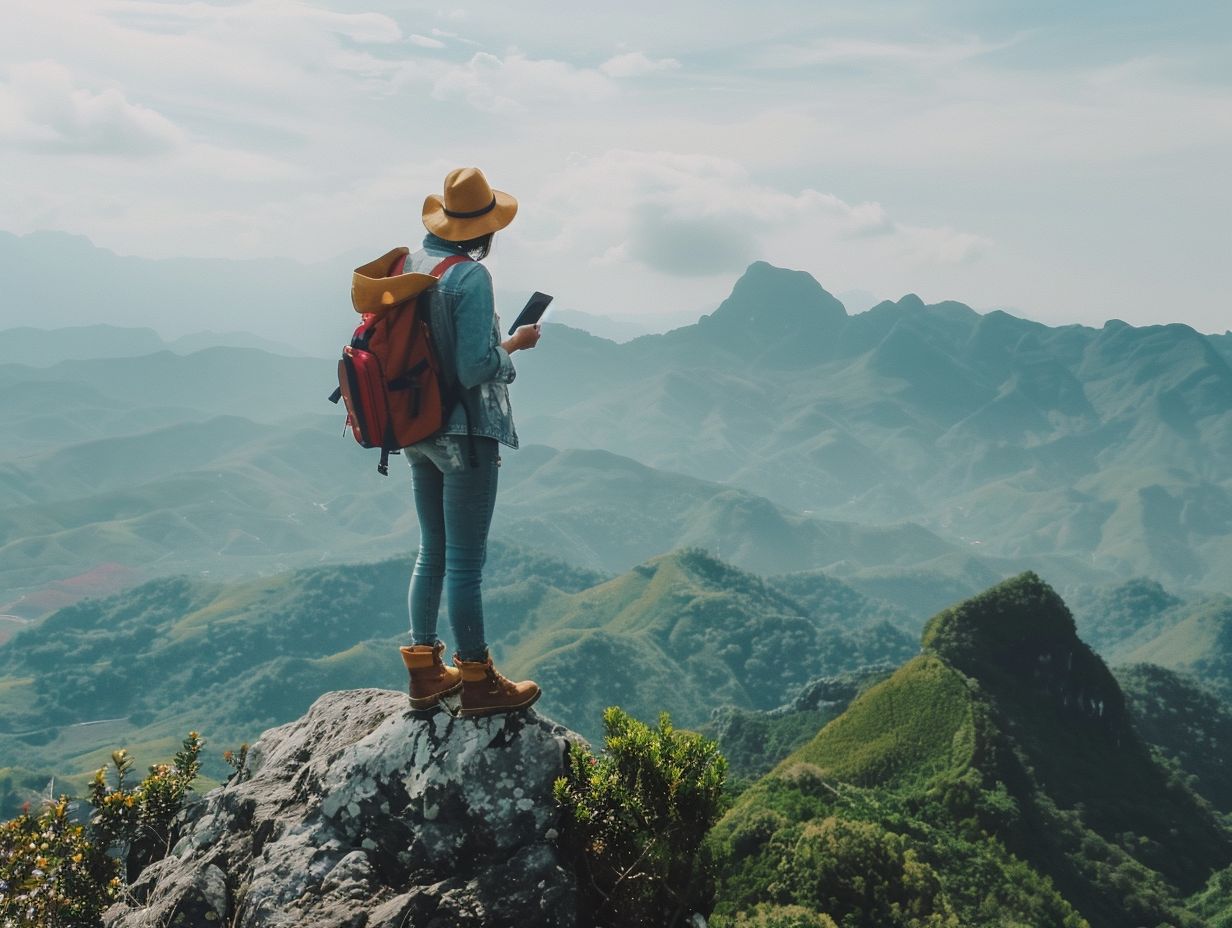Embarking on a hiking adventure is not just about reaching the summit – it’s also about capturing and preserving the memories you make along the way.
We will explore the benefits of documenting your hiking adventures and provide tips on how to prepare for the journey. From selecting the right equipment to choosing the perfect trail, we’ve got you covered. Plus, we’ll share photography and journaling tips to help you immortalise your outdoor experiences.
So grab your gear and get ready to document your next hiking adventure!
Key Takeaways:

- Documenting your hiking adventures allows you to relive the memories and share your experiences with others.
- Before hitting the trails, make sure to pack essential photography and journaling equipment and choose a hiking trail that suits your preferences and abilities.
- When photographing, pack light, use the right camera settings, and capture both the scenery and your hiking companions. For journaling, bring a compact notebook and write down your thoughts, feelings, and details about the hike and trail.
How to Prepare for Documenting Your Hiking Adventures?
Preparing to document your hiking adventures involves carefully selecting the appropriate equipment and meticulously planning the structure of your entries to ensure the comprehensive capture of all essential details of your journey.
What Equipment Do You Need?
To effectively document hiking adventures, it is necessary to have essential equipment, such as a compact journal such as Moleskine or Rite-in-the-Rain notebooks, in addition to a durable storage solution like Ziplock bags to safeguard notes.
Utilising a reliable pen or a set of colored markers allows for the addition of creative elements to journal entries.
Integration of an iPhone or a similar digital device can prove advantageous for swiftly jotting down notes, capturing photographs of breathtaking vistas, and recording memorable instances along the trail. These electronic tools can also function as backups for written notes, ensuring meticulous preservation of details.
By amalgamating both traditional and digital components, one can construct a comprehensive hiking journal that encapsulates the essence of outdoor experiences.
What Should You Consider Before Choosing a Hiking Trail?
Before selecting a hiking trail, it is essential to take into account a variety of factors, including the trail’s level of difficulty, length, and the geographical areas it traverses. Among the popular options often considered are the Pacific Crest Trail (PCT), the Appalachian Trail, and various routes within Banff National Park.
Thoroughly researching trails before setting out on a hike can significantly enhance the overall hiking experience. The utilisation of tools such as the Guthook app can provide in-depth trail information, user reviews, and real-time updates on trail conditions, thereby facilitating a well-knowledge-based decision making process.
It is imperative to realistically evaluate and assess one’s personal fitness levels when selecting a hiking trail that aligns with individual capabilities. Factors such as hiking goals and preferences should be taken into consideration; for instance, those who appreciate scenic vistas may prioritise trails featuring panoramic viewpoints, while individuals seeking solitude may opt for less frequented routes.
Photography Tips for Hiking Adventures

Photography plays a crucial role in documenting hiking adventures, and adhering to specific tips can help capture the breathtaking scenery and memorable experiences of the journey.
1. Pack Light and Bring Essential Gear
When preparing for a hiking expedition, it is imperative to prioritise minimalism and carry only essential equipment.
Brands like Gossamer Gear provide lightweight gear options that are particularly suited for prolonged trails. Having lightweight equipment not only augments mobility and endurance during the trek but also alleviates physical strain on the body.
Essential photography gear for hiking encompasses a compact camera or a lightweight DSLR, versatile lenses such as wide-angle or telephoto lenses, a portable tripod like the Gossamer Gear LT3C Carbon, and a sturdy camera bag for protection.
Investing in lightweight gear enables individuals to capture picturesque moments without being encumbered, ensuring the ability to fully appreciate the natural splendour while navigating through demanding terrains.
2. Use the Right Camera Settings
Accurate camera settings are paramount for capturing high-quality photographs during hiking excursions, whether utilising a professional camera or a smartphone such as an iPhone. When configuring the camera, meticulous attention should be directed towards the aperture setting, which governs the quantity of light penetrating the lens.
In well-illuminated surroundings, opting for a smaller aperture (higher f-number) facilitates the production of sharper images. The adjustment of shutter speed is pivotal in either arresting fast-moving subjects or introducing motion blur to cascading water bodies. Altering the ISO setting influences the camera’s light sensitivity, proving advantageous in low-light settings.
For instances of bright, sunlit hiking trails, a preference for lower ISO values is recommended to avert overexposure. Additionally, smartphone cameras present a myriad of modes such as HDR and portrait, which serve to effortlessly enhance the quality of your hiking snapshots.
3. Capture the Scenery and Wildlife
The documentation of hiking adventures through capturing the scenery and wildlife is an essential aspect, enabling individuals to exhibit the natural beauty and biodiversity of the trails.
To effectively photograph landscapes and wildlife, it is advisable to adhere to the rule of thirds in composition. By positioning key elements of the scene off-centre, a visually compelling image can be created.
It is recommended to explore various angles and perspectives to introduce depth and dimension to the photographs. When photographing wildlife, it is important to maintain a safe distance to ensure the preservation of their natural behaviour and safety.
The timing of photography plays a critical role in achieving desirable results. Early morning and late afternoon are typically optimal times for capturing stunning landscapes and wildlife in their natural habitat, as the lighting conditions during these periods are conducive to producing high-quality images.
4. Take Candid Shots of Your Hiking Companions
Capturing candid photographs of hiking companions enhances the personal aspect of hiking documentation, preserving authentic moments and interactions that occur during outdoor excursions.
To ensure the capture of candid shots without disrupting the organic flow of the hike, it is advisable to utilise a telephoto lens or zoom function to maintain an appropriate distance.
By blending into the surroundings and observing from a distance, individuals can record genuine expressions and actions without intruding on the natural dynamics of the moment. The use of burst mode on cameras can facilitate the efficient capturing of fleeting moments.
These candid photographs serve as genuine keepsakes, depicting the unfiltered emotions and camaraderie experienced during hiking adventures, thereby preserving memories that might have otherwise escaped notice.
5. Experiment with Different Angles and Perspectives
Exploring diverse angles and perspectives can elevate the visual allure of photographs, offering a distinctive portrayal of the hiking trails and their environs. An effective approach involves integrating low-angle shots to present the lofty trees and rough topography from an unconventional vantage point.
Incorporating reflections in puddles can introduce an intriguing dimension, engendering a perception of depth and enhancing the landscape’s aesthetics twofold. By manoeuvring through various angles, one can accentuate concealed intricacies and textures, infusing a novel and dynamic essence into the photography.
It is crucial to note that each angle presents a distinct narrative to convey and a novel perspective to delve into.
Journaling Tips for Hiking Adventures

Keeping a diary is a highly effective method for meticulously recording your hiking escapades. By adhering to these guidelines, one can craft detailed and engaging entries that encapsulate the true essence of their travels.
1. Bring a Compact Notebook or Journal
It is imperative to have a compact notebook or journal, such as a Field Notes notebook or a Moleskine, when embarking on hiking adventures to conveniently document experiences while on the move. These compact notebooks are specifically engineered to endure the demands of outdoor settings, ensuring the preservation of notes and memories even in challenging conditions.
Their robust covers and top-notch paper quality render them dependable companions for hiking excursions. The modest dimensions of these notebooks facilitate effortless storage in a rucksack or pocket, enhancing their portability. This feature plays a pivotal role in capturing fleeting moments of inspiration or recording critical details while exploring nature trails and picturesque landscapes.
2. Write Down Your Thoughts and Feelings
Documenting your thoughts and emotions whilst hiking contributes a personal element to your journal, enabling reflection on your experiences and feelings. When recording the specifics of the sights, sounds, and scents encountered along the trail, a detailed narrative is formed, enhancing the portrayal of your journey on paper.
Maintaining honesty and descriptive precision in your entries enables a comprehensive capture of each moment, ranging from triumphant summit achievements to contemplative instances of solitude.
Through genuine emotional expression, a more compelling journal is crafted for personal enrichment, whilst also providing an invitation for prospective readers to immerse themselves in the hike through your perspective.
3. Describe the Scenery and Surroundings
Incorporating comprehensive descriptions of the scenery and surroundings in one’s journal is instrumental in generating vivid imagery, enabling readers to immerse themselves in the hiking experiences recounted.
When articulating landscapes, it is paramount to contemplate the various elements present, including colours, shapes, and textures. For example, one may highlight the verdant foliage of the forest, the rugged contours of the mountains, or the tranquil undulations of a placid lake.
Introducing sensory specifics such as the fragrance of pine trees, the tactile sensation of soft moss underfoot, or the melodic chirping of birds can transport the audience directly into the narrative.
Emphasising distinctive weather phenomena such as a resplendent sunset casting hues across the sky or a sudden downpour infusing a sense of theatrics into the tale can render the descriptions more captivating.
Moreover, it is imperative to make reference to prominent landmarks that serve as focal points, whether it be a cascading waterfall, a historic edifice, or a charming hamlet nestled along the trail.
4. Include Details about the Hike and Trail
Incorporating specific details concerning the hike and trail, such as precise locations, trail designations, and notable landmarks along the route, serves to provide valuable contextual information within your journal entries.
Recording the trail conditions, encompassing aspects like weather patterns, terrain characteristics, and changes in elevation, holds significant importance as these variables can substantially influence your hiking experience. Additionally, documenting the distance covered each day is instrumental in accurately monitoring your progression along the trail.
Furthermore, it is advisable to make note of any encountered challenges during the hike, such as steep inclines, river crossings, or intricate terrain passages. To effectively organise these details within your journal, you may contemplate structuring dedicated sections for each day or segment of the hike.
A suggested approach is to include a succinct summary at the commencement of each entry, outlining the key aspects discussed therein. This practice facilitates ease of reference when revisiting past entries at a later time.
5. Add Personal Touches and Memories
Incorporating personal anecdotes and memories into journal entries enhances the uniqueness and significance of your documentation by reflecting your distinct experiences and adventures.
The inclusion of anecdotes can imbue your journal with vibrancy, such as reliving the exhilaration felt while exploring a new city or the serene tranquillity experienced during a hiking excursion.
Additionally, incorporating quotes from esteemed authors, mentors, or your own reflections can provide valuable insights and motivation when revisiting your entries. These components serve to enrich the content of your journal, transforming it into a cherished memento that encapsulates your identity and the path you have traversed.
Frequently Asked Questions

What is the best way to document my hiking adventures?
One of the best ways to document your hiking adventures is through a combination of photography and journaling. These two methods will allow you to capture the memories and experiences of your hikes in a tangible and lasting way.
What kind of camera should I use for documenting my hikes?
The type of camera you use will depend on your personal preferences and budget. You can use a professional DSLR camera, a point-and-shoot camera, or even your smartphone camera. The key is to choose a camera that you are comfortable using and that can capture high-quality images.
How can I take better photos while hiking?
To take better photos while hiking, try to capture the scenery and landscapes from different perspectives. Experiment with different angles, lighting, and composition to add variety to your photos. It is also important to always be prepared with extra batteries and memory cards to ensure you don’t miss any photo opportunities.
What should I include in my hiking journal?
Your hiking journal should include details about your route, distance, and any interesting or memorable moments from your hike. You can also include sketches, quotes, and notes about the flora and fauna you encountered. Don’t forget to also include photos and mementos such as pressed flowers or leaves.
How can I make my hiking journal more creative?
There are many ways to make your hiking journal more creative. You can use different coloured pens and markers, add stickers or washi tape, and include hand-drawn illustrations. You can also try using different writing styles and formats, such as bullet journaling or scrapbooking, to make your journal more visually appealing.
What are some tips for staying organised while documenting my hikes?
To stay organised, it is helpful to create a system for organising your photos and journal entries. This could include labelling your photos by date and location, and keeping your journal entries in chronological order. You can also use a digital platform, such as a blog or social media account, to easily organise and share your hiking adventures.

